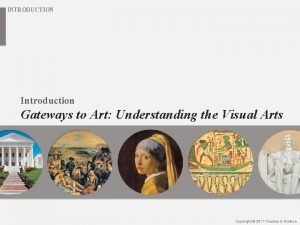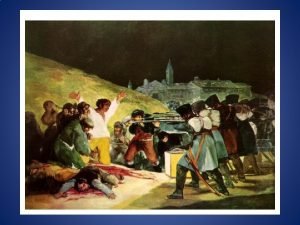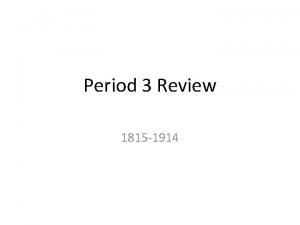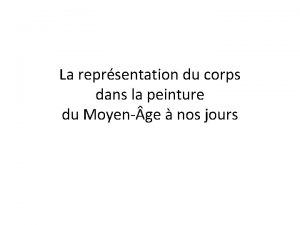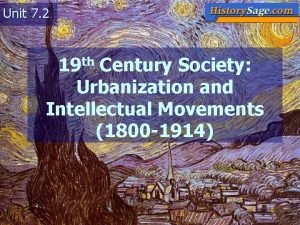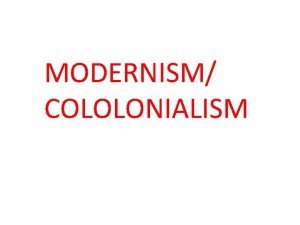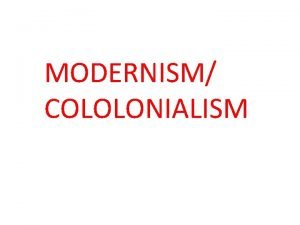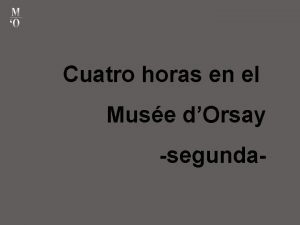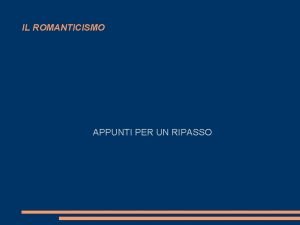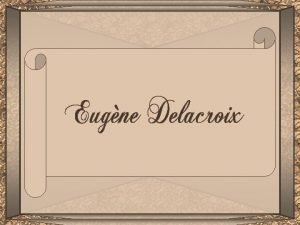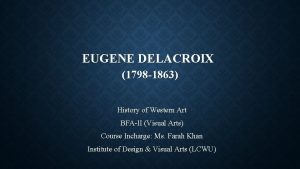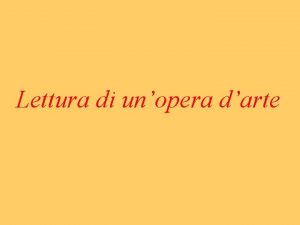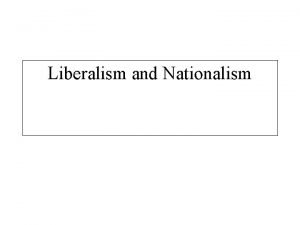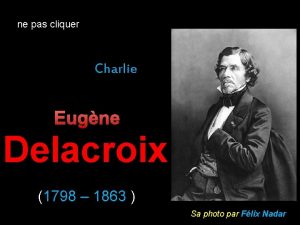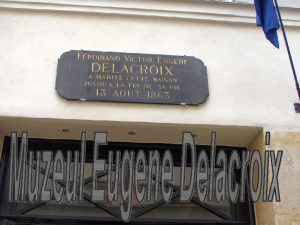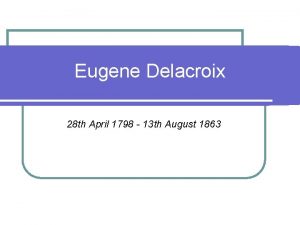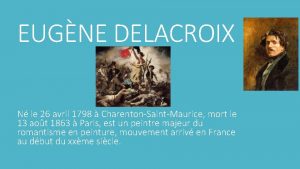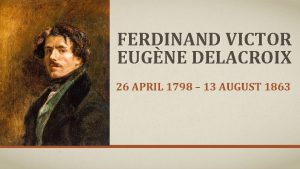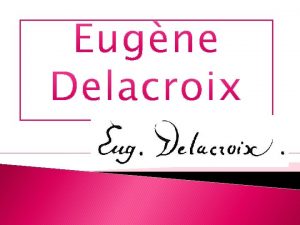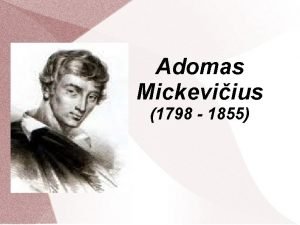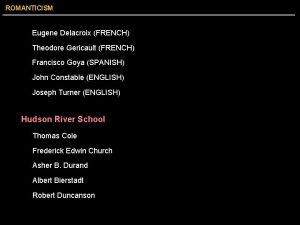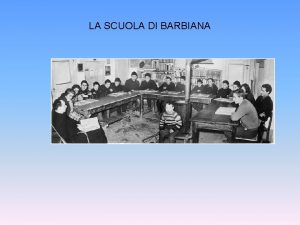EUGENE DELACROIX 1798 1863 History of Western Art




















- Slides: 20

EUGENE DELACROIX (1798 -1863) History of Western Art BFA-II (Visual Arts) Course Incharge: Ms. Farah Khan Institute of Design & Visual Arts (LCWU)

“Nature is a dictionary; one draws words from it” Eugene Delacroix “The source of genius is imagination alone, . . . the refinement of the senses that sees what others do not see, or sees them differently” Eugene Delacroix

EUGENE DELACROIX • Delacroix is widely regarded as the leader of the Romantic movement in 19 th century French art. His life and work embodied the movement’s concern for emotion, exoticism, and the sublime, and his painting style - full of lush, agitated brushwork and pulsating with vivid color - was in direct contrast to the cool and controlled delineations of his peer and rival, Ingres. • Delacroix avoided academic conventions in his choice of subjects, favoring scenes from contemporary history rendered on a large scale in the most dramatic of fashions, with visibly energized brushwork and dynamic figural compositions. • His work also embodies Romanticism’s obsession with the exotic Other, seen in his paintings inspired by a transformational trip to North Africa, but his animal pictures can also be viewed in this vein. • Interestingly, many of his works were based on direct observation of nature (he was a prodigious draftsman and took an interest in early photography), which he then combined with a narrative imagination, not surprising given his intimacy with many of the most famous writers of his day. • Delacroix’s debut at the Paris Salon of 1822, in which he exhibited his first masterpiece, Dante and Virgil in Hell, is one of the landmarks in the development of French 19 th-century Romantic painting.

EUGENE DELACROIX • Dante and Virgil in Hell was inspired by Dante’s Divine Comedy, but its tragic feeling and the powerful modeling of its figures are reminiscent of Michelangelo, and its rich color shows the influence of Peter Paul Rubens. Among Delacroix’s contemporaries, Gericault, who was the young painter’s best friend who left strong influence on his style. • Many of Delacroix’s Salon paintings depicted dramatic scenes drawn from contemporary history as well as literature. Some of the subjects were shocking for their violence and unabashed portrayal of human suffering, such as Death of Sardanapalus and Massacre at Chios. These works signaled a new direction in modern art, one that emphasized emotional content above order and rationality. • Delacroix’s use of color was influential in the development of both Impressionist and Post. Impressionist painting. His inspiration came chiefly from historical or contemporary events or literature, and a visit to Morocco in 1832 provided him with further exotic subjects. • His animal paintings embody Romanticism’s love of all things wild and untamed. He based these works on studies he made in Paris’s Jardin des Plantes, where he sketched lions in the zoo, as well as drawings he made of domestic house cats.

EUGENE DELACROIX • Delacroix’s modest still life’s are nonetheless masterful in their use of color harmonies and composition, and demonstrate the artist’s desire to master all artistic genres, as a true virtuoso. These works would later influence Impressionist artists who rendered the traditional genre of still life in fresh and modern ways. • Delacroix gained many significant commissions to paint public buildings and churches in France. These decorative projects, such as ceiling paintings and wall murals, allowed the artist to work on a larger scale than ever before, and would later influence the Nabis and other Symbolists who sought to free painting from the confines of the easel in the late nineteenth and early twentieth century. • The visual impact of Delacroix’s art owes a great deal to his study of color; he understood (and employed) such principles as the division of tones and the harmony of contrasts, both of which would be enormously important for later modernists such as Van Gogh and Seurat

MAIN FEATURES • Delacroix was considered as “The Pioneer of Modern rt”. • He was the leader and most typical of French Romantic painters. • He was a painter, water colorist, musician, poet, architect, lithographer and a critic. • He got the mood of painting from Gericault and Technique from Constable. • Delacroix’s use of expressive brushstrokes and his study of the optical effects of colour profoundly shaped the work of the Impressionists. • His passion for the exotic inspired the artists of the Symbolist movement. He was a fine lithographer and illustrated various works of Shakespeare, Scott and Goethe. • Delacroix took for his inspiration the art of Rubens and painters of the Venetian Renaissance, with emphasis on colour and movement rather than clarity of outline and carefully modeled form. • Dramatic and romantic content characterized the central themes of his maturity, and led him not to the classical models of Greek and Roman art, but to travel in North Africa, in search of the exotic. He visited Algeria, Morocco, North Africa and got inspiration from its dusty landscape, light, colors and bright costumes.

• He once said: “A work of art is above all an adventure of the mind”. He used the tool of imagination in his practice too. • He was basically a colorist. He believed that in painting, colour was much important than draftsmanship and imagination than knowledge. • His technique was sketchy when he painted coloured animals in action. • According to him “Beauty is not in rhythm, proportion and balance rather beauty is actually in nature, in real and in raw material”. • His juxtaposed spots of colours provides greater freshness and vividness to his work. He was of the view that “Painting is a bridge b/w the thought of the artist and the thought of the observer”. • He also said : “The primary merit of a painting is to be a feast for the eye”

THE BARQUE OF DANTE / DANTE AND VIRGIL IN HELL

LIBERTY LEADING THE PEOPLE

DEATH OF SARDANAPALAS

WOMEN OF ALGIER

MASSACRE AT CHIOS

BATTLE OF TAILLEBOURG

BATTLE OF TAILLEBOURG

SKETCH OF LION HUNT

LION HUNT

TIGER AND SNAKE

Arab Horseman attached by a Lion

Portrait of an Algerian Woman

Self Portrait
 White vertical water
White vertical water Who painted liberty leading the people
Who painted liberty leading the people July 1-4 1863
July 1-4 1863 Timeline for the industrial revolution
Timeline for the industrial revolution Manet, olympia, 1863
Manet, olympia, 1863 Impressionism 1867-1886
Impressionism 1867-1886 Edouard manet olympia 1863
Edouard manet olympia 1863 Olympia gauguin
Olympia gauguin Edouard manet olympia 1863
Edouard manet olympia 1863 Edouard manet olympia 1863
Edouard manet olympia 1863 Olympia, 1863
Olympia, 1863 Constitucion de 1863
Constitucion de 1863 Hjälper sedan 1863
Hjälper sedan 1863 Nov 19 1863
Nov 19 1863 During the free banking era between 1837 and 1863
During the free banking era between 1837 and 1863 Define soddies
Define soddies Alex delacroix
Alex delacroix Caccia al leone delacroix
Caccia al leone delacroix Goya delacroix
Goya delacroix Eugne delacroix
Eugne delacroix Theodore gericault
Theodore gericault
